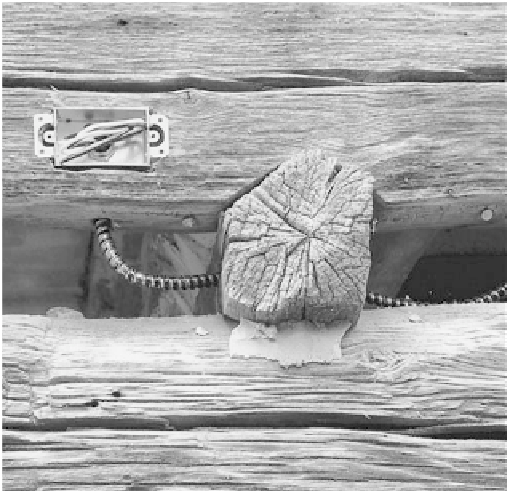Civil Engineering Reference
In-Depth Information
That's one plateau. You still must cook, but I
learned my limited culinary skills at a woodstove, and
several of my friends now use wood from October to
May. Hot water can be had in reasonable quantities
from the reservoir in the cookstove, and you
can
dip
in your creek in summer.
If you choose to electrify your new or restored log
house, there are a few things to know. Even if you're
outside the cities that have strict codes, your local
power company will discourage the kind of offhand
wiring that could burn down your house. They pay
specialists to provide information and suggestions, so
go see one.
Find out if the company will even extend its line to
your site. Then, if you want to bury the wire, get its
specifications. Depending on the usage you and the
company's specialist anticipate, you'll need perhaps a
100-amp or even a 200-amp entry panel, which con-
nects to the meter base. Different-size conduits are
required for different amperage.
Kitchens
Often we recommend that the kitchen and bathrooms
be placed in the frame or post-and-beam additions of
log houses, since it is easier to hide plumbing in frame
walls. However, a kitchen can also be built in a log
room. The kitchen is such a personal space that it's
hard to generalize here. Our clients have wanted
everything from open shelves to granite countertops
(sometimes both). Any kitchen design should mini-
mize space among the three most functional centers:
stove, sink, and refrigerator. Log walls affect kitchen
layout little, unless pipes from upstairs must come
down here. Sometimes this is unavoidable, so the
pipes are hidden in chinking space, in vertical chases
along the wall, in horizontal chases between beams, or
in cabinets.
A colorful addition to a kitchen is a cooking fire-
place, with crane, Dutch ovens, and kettles. This can
sometimes be built back-to-back with the main fire-
place, in the same chimney. The Sam Black Tavern
restoration was done this way, a duplicate of the 1769
original. We often wondered how the cooks worked,
bent over those fireplaces. Today, you can keep the
ambience but make the kitchen fireplace more pleas-
ant by raising the hearth to the desired height.
Installing Utilities
Electricity is the utility you'll need (or miss) most. I
favor cutting our dependency on this form of energy as
much as possible, since we have been grossly spoiled
in the past two generations by gadgetry that plugs in.
We have friends who use bottled gas for their refrig-
erator, water heater, and small cookstove (in sum-
mer); they use a wood cookstove in winter, and light
with kerosene. They have a battery-powered tape
player. But they do keep a freezer and a washing
machine at a friend's house.
I grew up in a log cabin where we had no electric-
ity until I was 15. We carried water, sometimes chilled
things in a spring, lighted the house with kerosene
lamps, listened to a battery-powered radio, and
cranked a Victrola. As I remember it, our first
purchases for electric usage were lights, a refrigerator,
and a water pump.
It looks best if the electric box is mortised into the log face, because
the fixture or outlet fits flush and vertical. This work takes more time
and requires a lot of drilling and chiseling, but the end product is very
satisfying. Here the box is chiseled into the exterior of the log and will
hold a lighting fixture next to the back door. In this photo, the wiring
is encased in conduit. We do not normally use any wire other than
Romex, since conduit is necessary neither to meet building codes nor
for other criteria. However, the electrician preferred this method and
the owner approved. Running Romex wire between and through drilled
logs works just as well, as long as all the building codes are met.



